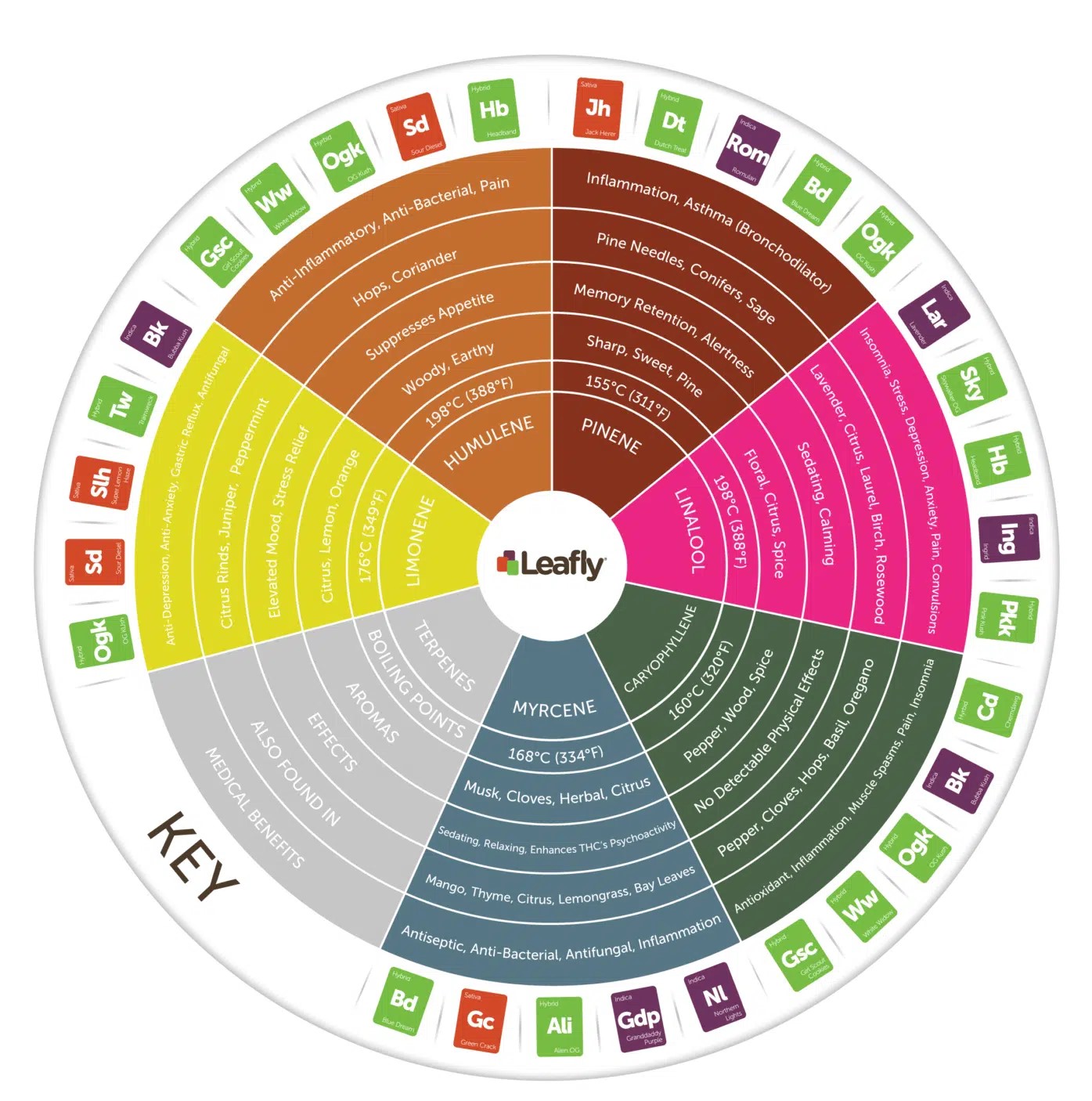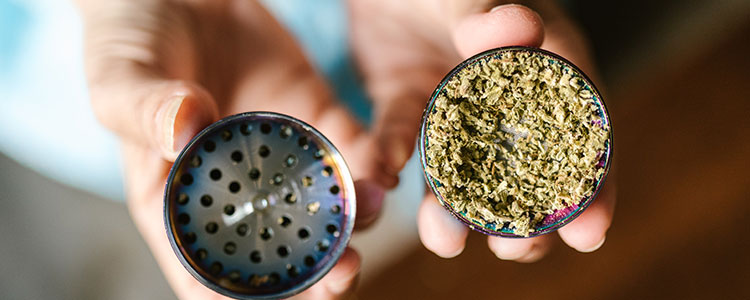How To Interpret A Terpene Chart To Enhance Your Cannabis Experience
To make sense of this complex world of aromas, scientists and enthusiasts have developed terpene chart, providing a visual representation of these intricate compounds and their characteristics.
Author:Andrew StevensonReviewer:Johnathan MillerFeb 08, 202496 Shares96.4K Views

Terpenes, the aromatic compounds found in various plants, have recently gained significant attention for their diverse range of flavors, scents, and potential therapeutic benefits.
Cannabis enthusiasts, in particular, have taken a keen interest in terpenes due to their role in the unique aroma and effects of different strains.
To make sense of this complex world of aromas, scientists and enthusiasts have developed terpene chart, providing a visual representation of these intricate compounds and their characteristics.
What Are Terpenes?
Terpenes are aromatic chemicals present in plant essential oils. They perform a variety of tasks that influence the color and taste character of each plant. Terpenes may play a crucial part in defining the medicinal and mood-altering effects of your favorite cannabis strains, as we're discovering.
Terpene structures are classified according to the number of isoprenes units they contain: mono, di, tri, tetra, and sesquiterpenes. Isoprene terpenes protect against abiotic (non-living) stressors such as the weather.
Mono and sesquiterpenes, on the other hand, operate as guardians and communicators between the plant, other plants, the climate, and organisms.²
Terpenes are present in cannabis in the trichomes, which are resin-filled bulbous sticky hairs found mostly on the buds, or nugs.
The study of how the body interacts with terpenes, particularly in regard to cannabis, is still in its early phases. Terpenes, according to the notion, collaborate with the rest of the cannabis plant's chemical composition (cannabinoids and flavonoids).
The entourage effect is caused by this synchrony, which provides consumers with a distinct psychedelic experience with each strain.
Terpenes may be extracted and utilized in goods such as cleaning solvents, insecticides, and dyes - consider pine scents (Pinesol cleaner includes the terpene pinene). They may also be separated and used in certain cannabis products, like as edibles, to provide the desired effect.
Terpenes are not found just in cannabis. Terpenes that are popular among non-cannabis users include:
- Thymol- Thymol is a terpene present in thyme and other herbs, as well as cheeses such as blueberries, mango, and gruyere. It has a light, sweet scent. It is utilized in cooking as well as antibacterial3 uses.
- Borneol- Found in cinnamon and over 250 other essential oils, Borneol has anti-anxiety and anti-inflammatory qualities.
- Sabine- Sabine is a warm spicy scent found in turmeric. According to some research, it may help enhance immunity5 and combat bacterial infections.
What Is A Terpene Chart?
Terpene charts are heuristic tools for interpreting the effects, tastes, scents, and/or crucial information associated with common terpenes. Terpene charts often concentrate on the terpenes that are widely present in cannabis or hemp and may be extracted and utilized in other products to achieve certain outcomes.
Terpene charts are often in the shape of a wheel, although they may also be in the form of bar charts. The terpene profile, which some companies provide to customers, is a list of the top terpenes found in each cultivar. This profile, along with the cannabinoid content, may help users predict how the strain will interact with their body.
A terpene chart may assist medical cannabis patients and recreational cannabis users understand terpenes and their potential effects on the body.
How To Read Terpenes Chart
Always begin with the key while reading terpene charts. The names of six common terpenes present in cannabis and hemp may be found in the biggest quadrants closest to the center: humulene, pinene, linalool, caryophyllene, myrcene, and limonene.
Myrcene has a boiling point of 168°C, as you can see. It has an aromatic characteristic of musk, cloves, herbaceous, and citrus.
According to Leafly's terpene chart, Myrcene is known to have calming qualities and may boost the psychoactivity of THC (the cannabinoid in cannabis that causes people to feel "high").
Myrcene may be found in mango, thyme, citrus, lemongrass, and bay leaves, and it has antibacterial, antifungal, and anti-inflammatory properties.
Components Of A Terpene Chart
A typical terpene chart provides the following information:
- Terpene Names -The chart lists the names of different terpenes present in a specific cannabis strain. Common terpenes include myrcene, limonene, pinene, and caryophyllene, among others.
- Terpene Concentrations -Terpene charts display the concentration of each terpene in the cannabis strain. These concentrations are usually represented as a percentage of the total terpene content.
- Aroma and Flavor Descriptions -Many terpene charts include descriptions of the aromas and flavors associated with each terpene. For example, myrcene is often described as having an earthy and musky aroma, while limonene is associated with a citrusy scent.
- Effects and Potential Benefits -Some terpene charts also provide information on the potential effects and medicinal benefits associated with specific terpenes. For instance, myrcene may be linked to sedative effects, while limonene is believed to have mood-enhancing properties.
- Strain Names -Terpene charts are typically specific to particular cannabis strains. Therefore, the chart will include the names of these strains, allowing consumers to identify which terpenes are present in their preferred strains.
What Are The Common Cannabis Terpenes?
The cannabis plant has around 150 distinct terpenes. The majority of terpene research has concentrated on a single isolated terpene and employs greater concentrations than consumers would find in commercially available strains.
Terpenes that are often used include:
- Myrcene- Myrcene is the most prevalent terpene discovered in cannabis, and it is abundant in strains such as Grand Daddy Purple, OG Kush, Jack Herer, and Soul Diesel. It is often used in perfumes because to its pleasant and sweet scent. One study revealed that it may improve transdermal absorption and cannabis transport across the blood-brain barrier, but further research is required.
- Caryophyllene- This is a terpene that may be found in black pepper, cloves, oregano, and basil. It has a strong woodsy odor. Caryophyllene's anti-inflammatory qualities and capacity to help with gastrointestinal ailments have been studied. Caryophyllene may be found in cannabis strains such as Zkittles, Bubba Kush, GG4, and Blue Dream.
- Limonene- One of the most well-known terpenes is limonene. It is found in citrus fruits such as oranges, lemons, and grapefruits and is often used in perfumes, soaps, and meals. It has long been utilized in Japanese medicine and has lately been explored for its anti-inflammatory properties. Current research suggests that limonene may have antioxidant properties and reduce cancer cell expression in women with breast cancer.
Terpene Benefits
Chemical messengers like terpenes are essential in nature. Because of their function, they are able to interact with other substances in cannabis and the human body after ingestion.
Through a synergistic action on the human endocannabinoid system (ECS), these chemicals moderate cannabis' medicinal and euphoric effects.
Sleep, pain, memory, immunological response, inflammation, and many other activities may all benefit from this network of chemical receptors for cannabinoids. Terpenes have several therapeutic benefits, according to scientific research.
- Anti-cancer- As terpenes seem to specifically target cancer cells and generate effects like cancer cell death and decreased cell viability, they are able to inhibit the progression of cancer.
- Pain Relief- The analgesic qualities of terpenes may be useful for those being treated for chronic pain problems like multiple sclerosis or fibromyalgia.
- Anti-Inflammatory- Terpenes are anti-inflammatory, which means they may help patients with asthma, arthritis, and even certain forms of cancer.
- Reducing Anxiety- Terpenes may provide relief for patients suffering from anxiety disorders or anxiety brought on by stress.
- Mood-Boosting- Terpenes' anti-depressant properties are helpful for many people, but individuals with depression or other mood disorders stand to gain the most.
- Anti-Convulsive- Some terpenes have anticonvulsant characteristics that may help those who suffer from epileptic seizures and epilepsy.
- Antioxidant- Antioxidants are substances that neutralize the effects of free radicals by either trapping them or converting them into less dangerous forms.
Utilizing Terpene Charts
Terpene charts are essential tools for cannabis enthusiasts, growers, and consumers alike. These charts provide valuable information about the terpene profiles of various cannabis strains, enabling users to make informed decisions about their cannabis experience. Here's a detailed look at how terpene charts can be effectively utilized:
Strain Selection
Terpene charts are invaluable when selecting a cannabis strain. Each strain has a unique terpene profile that contributes to its aroma, flavor, and effects. By referring to a terpene chart, consumers can identify which strains contain the specific terpenes they prefer. For example, someone seeking a relaxing strain might look for high levels of myrcene, while those interested in an uplifting experience may opt for strains rich in limonene.
Aroma And Flavor Preferences
Terpene charts can help users discover strains with aromas and flavors that resonate with their preferences. Whether you're looking for a strain with fruity, citrusy, earthy, or spicy notes, terpene charts can guide you to the right choice. This is particularly useful for those who enjoy the sensory aspects of cannabis consumption.
Medicinal Benefits
Beyond recreational use, terpenes also offer potential medicinal benefits. Different terpenes are associated with various therapeutic effects, such as pain relief, anxiety reduction, and anti-inflammatory properties. Users seeking specific medicinal effects can consult terpene charts to identify strains that align with their needs.
Enhancing Growing Practices
For cannabis cultivators, terpene charts are essential for optimizing growing conditions. By understanding the terpene preferences of a particular strain, growers can adjust environmental factors like temperature, humidity, and nutrient levels to encourage the production of desired terpenes. This allows cultivators to tailor the aroma and effects of their cannabis plants.
Tailoring Consumption Methods
Terpene charts can also influence how users choose to consume cannabis. For instance, vaporizing cannabis at specific temperatures can maximize the release of certain terpenes, enhancing the overall experience. Users can experiment with different consumption methods to fully appreciate the terpene profiles of their chosen strains.
Product Label Verification
In regions with legalized cannabis markets, some products include terpene information on their labels. Consumers can cross-reference this data with terpene charts to ensure product accuracy and make informed purchases.
How To Use Terpene Charts
Using terpene charts effectively can significantly enhance your cannabis experience by helping you select strains that align with your preferences and desired effects.
Terpene charts provide valuable information about the aromatic compounds present in different cannabis strains, which contribute to their distinct flavors, scents, and potential effects. Here's how to make the most of terpene charts:
Understand Terpenes
Before using terpene charts, it's essential to familiarize yourself with the most common terpenes found in cannabis and their associated aromas, flavors, and potential effects. Some well-known terpenes include myrcene, limonene, pinene, and caryophyllene.
Identify Your Preferences
Determine your preferred aroma, flavor, and the effects you desire from cannabis. For example, do you enjoy citrusy, earthy, or floral scents? Are you seeking strains that provide relaxation, focus, or pain relief?
Access Terpene Charts
Terpene charts are often available online through cannabis websites, dispensaries, or educational platforms. Look for charts specific to the strains or products you're interested in.
Select The Right Strains
When using terpene charts to choose cannabis strains, consider the following factors:
- Look for strains with terpene profiles that match your preferences. For instance, if you love citrus flavors, strains high in limonene are a good choice.
- Pay attention to the potential effects associated with specific terpenes. If you're seeking relaxation, myrcene-rich strains might be suitable, while strains with pinene could provide an energy boost.
- If you're using cannabis for medicinal purposes, choose strains with terpenes known for addressing your specific health concerns, such as anxiety, pain, or inflammation.
Explore Strain-Specific Terpene Profiles
Terpene charts are often strain-specific. When you've identified a strain of interest, consult its terpene chart to learn more about its unique terpene composition.
Verify Terpene Information
In regions with legalized cannabis markets, always cross-reference the terpene information provided on product labels with the terpene chart for accuracy. This ensures you're getting what you expect.
Experiment And Keep Notes
Don't be afraid to experiment with different strains and terpene profiles to find what works best for you. Keep a journal or notes on your experiences to remember which strains you enjoyed and why.
Consider Customization (for Cultivators)
If you're a cannabis cultivator, terpene charts can guide your cultivation practices. Adjust environmental factors like temperature, humidity, and nutrient levels to influence terpene production and create custom-tailored strains.
Pair Terpenes With Cannabinoids
Remember that terpenes work synergistically with cannabinoids like THC and CBD. Consider the overall cannabinoid-terpene profile of a strain for a more comprehensive understanding of its effects.
Seek Expert Advice
If you're uncertain about which strains or terpenes to choose, seek advice from experienced budtenders at dispensaries or consult with medical professionals familiar with cannabis medicine.
FAQs - Terpene Chart
How Do Terpenes Impact Cannabis?
Terpenes in cannabis play a crucial role in determining the strain's aroma, flavor, and potential effects. They interact with cannabinoids to create a synergy known as the entourage effect, influencing the overall therapeutic experience.
Are Terpenes Only Found In Cannabis?
No, terpenes are not exclusive to cannabis. They are organic compounds found in various plants, including fruits, vegetables, and herbs. Cannabis, however, is well-known for its diverse terpene profiles.
Can Terpene Charts Help With Strain Selection?
Yes, terpene charts are valuable tools for strain selection. Enthusiasts can refer to these charts to identify strains with specific terpenes that match their desired aroma and effects.
How Can Terpene Charts Benefit Home Cannabis Cultivation?
Terpene charts can assist home cultivators in manipulating environmental factors to enhance specific terpenes in their cannabis plants. This allows for a more customized aroma and experience in the cultivated strains.
Final Words
Terpene chart provides an intricate glimpse into the aromatic and therapeutic world of cannabis and other plants.
By understanding these charts, enthusiasts, cultivators, and medical users can make more informed decisions about strain selection, cultivation practices, and therapeutic applications.
As research continues to unveil the complexities of terpenes, these charts will likely become even more sophisticated, offering deeper insights into the diverse world of aromas and their potential benefits.

Andrew Stevenson
Author
Meet Andrew Stevenson, a distinguished male writer whose passion and expertise encompass a wide array of topics, including global news, finance, health, celebrity culture, movies, and cryptocurrency. With a wealth of experience and a keen eye for detail, Andrew delivers engaging and informative content that resonates with readers from all walks of life. His insightful analysis of market trends, health breakthroughs, and the latest developments in entertainment captivates audiences, while his exploration of the burgeoning world of cryptocurrency offers invaluable insights into this rapidly evolving field. Andrew's commitment to excellence and his ability to distill complex information into accessible narratives make him a trusted source of knowledge and inspiration in today's dynamic media landscape. Join him on a journey of discovery as he illuminates the intersections of culture, finance, and technology, shaping the conversation one article at a time.

Johnathan Miller
Reviewer
Meet Johnathan Miller, an esteemed writer and analyst renowned for his expertise in global news, finance, health, and cryptocurrency. With a distinguished background in finance and a meticulous approach to research, Johnathan offers incisive insights into market dynamics and economic trends. His articles are characterized by a profound understanding of health-related issues and a clear articulation of the complexities surrounding cryptocurrency. Through his professional lens and commitment to excellence, Johnathan navigates the intricate webs of our interconnected world, delivering compelling analysis and thought-provoking commentary. Join him on a journey of discovery and enlightenment as he continues to shape discourse in these vital spheres.
Latest Articles
Popular Articles
